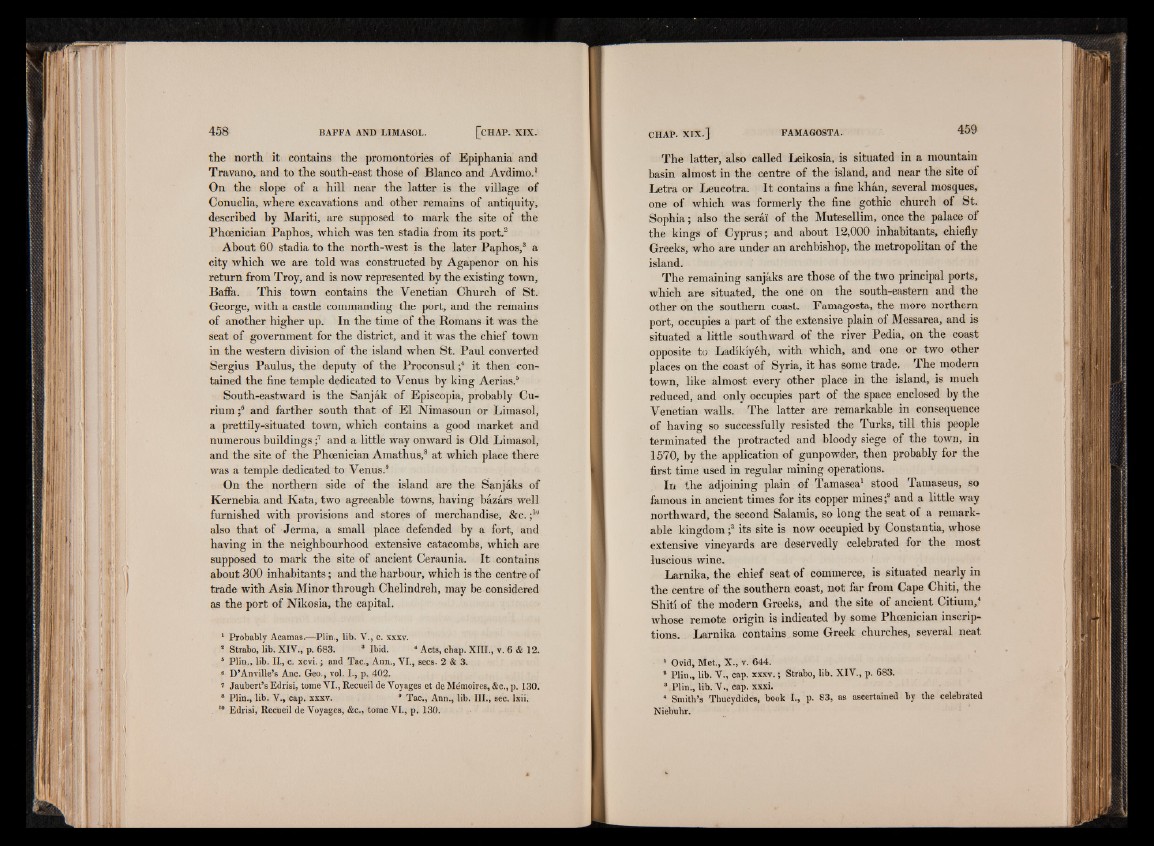
the north it contains the promontories of Epiphania and
Travano, and to the south-east those of Blanco and Avdimo.1
On the slope of a hill near the latter:is the village of
Conuclia, where excavations and other remains of antiquity,
described by Mariti, are supposed to mark the site of the
Phoenician Paphos, which was ten stadia from its port.2
About 60 stadia to the north-west is the later Paphos,3 a
city which we are told was constructed by Agapenor on his
return from Troy, and is now represented by the existing town,
BafFa. This town contains the Venetian Church of St.
George, with a castle commanding the port, and the remains
of another higher up. In the time of the Romans it was the
seat of government for the district, and it was the chief town
in the western division of the island when St. Paul converted
Sergius Paulus, the deputy of the Proconsul ;* it then contained
the fine temple dedicated to Venus by king Aerias.5
South-eastward is the Sanjâk of Episcopia, probably Curium
;6 and farther south that of El Nimasoun or Limasol,
a prettily-situated town, which contains a good market and
numerous buildings ;7 and a little way onward is Old Limasol,
and the site of the Phoenician Amathus,8 at which place there
was a temple dedicated to Venus.9
On the northern side of the island are the Sanjâks of
Kernebia and Kata, two agreeable towns, having bazars well
furnished with provisions and stores of merchandise, &c. ;10
also that of Jerma, a small place defended by a fort, and
having in the neighbourhood extensive catacombs, which are
supposed to mark the site of ancient Ceraunia. It contains
about 300 inhabitants ; and the harbour, which is the centre of
trade with Asia Minor through Chelindreh, may be considered
as the port of Nikosia, the capital.
1 Probably Acamas.—Plin., lib. V., c. xxxv.
! Strabo, lib. XIV., p. 683. 3 Ibid. * Acts, chap. XIII., v. 6 & 12.
3 Plin., lib. II., e. xcvi. ; and Tac., Ann., VI., secs. 2 & 3.
8 D’Anville’s Anc. Geo., vol. I., p. 402.
i Jaubert’s Edriai, tome VI., Recueil de Voyages et de Mémoires, &c., p. 130.
8 Plin., lib. V., cap. xxxv. “ Tac., Ann., lib. III., sec. lxii.
10 Edrisi, Recueil de Voyages, &c., tome VI., p. 130.
The latter, also called Leikosia, is situated in a mountain
basin almost in the centre of the island, and near the site of
Letra or Leucotra. It contains a fine khan, several mosques,
one of which was formerly the fine gothic church of St.
Sophia; also the serai of the Mutesellim, once the palace of
the kings of Cyprus; and about 12,000 inhabitants, chiefly
Greeks, who are under an archbishop, the metropolitan of the
island.
The remaining sanjaks are those of the two principal ports,
which are situated, the one on the south-eastern and the
other on the southern coast. Famagosta, the more northern
port, occupies a part of the extensive plain of Messarea, and is
situated a little southward of the river Pedia, on the coast
opposite to Ladikiy&h, with which, and one or two other
places on the coast of Syria, it has some trade, The modern
town, like almost every other place in the island, is much
reduced, and only occupies part of the space enclosed by the
Venetian walls. The latter are remarkable in consequence
of having so successfully resisted the Turks, till this people
terminated the protracted and bloody siege of the town, in
1570, by the application of gunpowder, then probably for the
first time used in regular mining operations.
In the adjoining plain of Tamasea1 stood Tamaseus, so
famous in ancient times for its eopper mines;2 and a little way
northward, the second Salamis, so long the seat of a remarkable
kingdom ;3 its site is now occupied by Constantia, whose
extensive vineyards are deservedly celebrated for the most
luscious wine,
Larnika, the chief seat of commerce, is situated nearly in
the centre of the southern coast, not far from Cape Chiti, the
Shiti of the modern Greeks, and the site of ancient Citium,4
whose remote origin is indicated by some Phoenician inscriptions.
Larnika contains some Greek churches, several neat
1 Ovid, Met., X., v. 644.
8 Plin., lib. V., cap. xxxv.; Strabo, lib. XIV., p. 683.
8.Plm., lib. V., cap. xxxi.
* Smith’s Thucydides, book I., p. 83, as ascertained by the celebrated
Niebuhr.